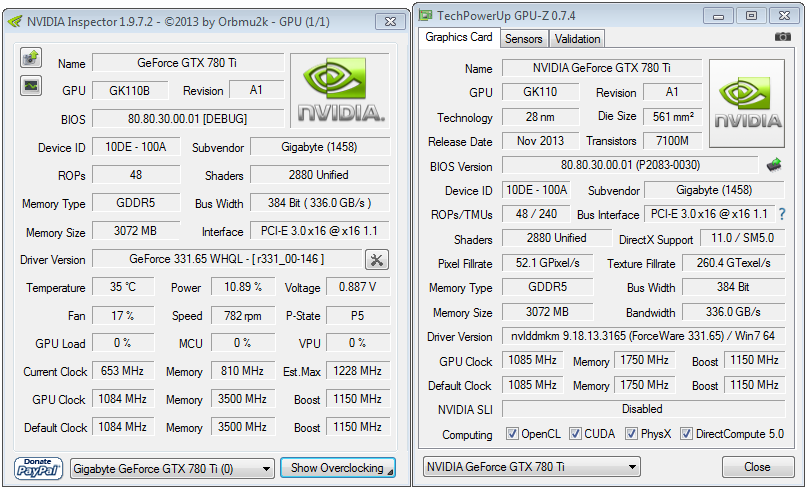Gigabyte GeForce GTX 780 Ti GHz Edition Review
Published by Christian Ney on 06.12.13Page:
 With the release of the new Geforce GTX 780 Ti GHz Edition, Gigabyte managed to beat other Nvidia AIC partners and it is actually the first custom GTX 780 Ti graphics card that we had a chance to play with. The new Gigabyte GTX 780 Ti GHz Edition is, at least currently, the fastest GTX 780 Ti graphics card on the market. Gigabyte pretty much used the same PCB as well as the same Windforce 3X 450W cooler as on its earlier released GTX 780 GHz Edition. As it did a great job back then we will find out if it is enough for the GTX 780 Ti as well.
With the release of the new Geforce GTX 780 Ti GHz Edition, Gigabyte managed to beat other Nvidia AIC partners and it is actually the first custom GTX 780 Ti graphics card that we had a chance to play with. The new Gigabyte GTX 780 Ti GHz Edition is, at least currently, the fastest GTX 780 Ti graphics card on the market. Gigabyte pretty much used the same PCB as well as the same Windforce 3X 450W cooler as on its earlier released GTX 780 GHz Edition. As it did a great job back then we will find out if it is enough for the GTX 780 Ti as well.
 Article in English
Article in English |
 Artikel in Deutsch
Artikel in Deutsch |
 Article en français
Article en français |
 Articolo in italiano
Articolo in italiano |
Presentation
Gigabyte is one of the first Nvidia add-in-card (AIC) partners to introduce custom GTX 780 Ti graphics card with Zotac, Gainward, Inno3D and EVGA. Gigabyte's new GTX 780 Ti GHz Edition graphics card got the same treatment as the GeForce GTX 780 "GHz Edition" released not long ago with the use of a custom PCB paired up with its own custom Windforce 3X 450W cooler.
It was quite a simple job for Gigabyte to do the GTX 780 Ti custom graphics card as it is pretty much identical to the GTX 780 GHz Edition, featuring the same PCB as well as the same cooler. We guess it was just a matter of Nvidia giving them a green light to come up with their own custom version.
As you can see from the GPU-Z screenshot below, Gigabyte decided to use a quite high factory-overclock on the new GTX 780 Ti GHz Edition. Actually this makes it the fastest GTX 780 Ti on the market. While the standard reference GTX 780 Ti GPU is set to work at 875MHz for the base GPU and 928MHz for the GPU Boost clock, the new Gigabyte GTX 780 Ti GHz Edition works at quite high 1'085MHz for the base clock and even more impressive 1'150MHz for the Boost GPU clock.
Unfortunately, no factory overclocking was done on the 3GB of GDDR5 memory that remains at recommended 1'750MHz (7'000MHz effective).
While the typical Boost clock is set at 1'150MHz, the maximum Boost of 1'228MHz was achieved quite easily and the GTX 780 Ti GHz Edition held that clock most of the load time due to good custom cooler as well as good TDP target (Nvidia's Boost technology being based on both temperature and power on this card, the latter being predominant). The GPU Max. Boost clock only dropped in Furmark down to 1'058MHz at 0.987V and was actually lower than the base clock which is the first time we see such behaviour with Nvidia's Boost technology. It also did not held in some games where it dropped from 1'228 to either 1'215 or 1'202 depending on the scenario, but that is not a big issue considering it actually stayed well above the advertised typical Boost clock.

Specifications
| GBT GTX 780 Ti GHz | GeForce GTX 780 Ti | GBT GTX 780 GHz | GeForce GTX 780 | |
| Chip | GK110-425-B1 | GK110-425-B1 | GK110-300-B1 | GK110-300-A1 |
| Process | 28 nm | 28 nm | 28 nm | 28 nm |
| Transistors | 7.10 billion | 7.10 billion | 7.10 billion | 7.10 billion |
| GPU clock | 1'085 MHz | 875 MHz | 1'020 MHz | 863 MHz |
| GPU Boost clock | 1'150 MHz | 928 MHz | 1'072 MHz | 900 MHz |
| Memory GDDR5 | 3'072 MB | 3'072 MB | 3'072 MB | 3'072 MB |
| Memory clock | 1'750 (7'000) MHz | 1'750 (7'000) MHz | 1'502 (6'008) MHz | 1'502 (6'008) MHz |
| Memory interface | 384 Bit | 384 Bit | 384 Bit | 384 Bit |
| Memory bandwidth | 336'000 MB/s | 336'000 MB/s | 288'400 MB/s | 288'400 MB/s |
| Shader Cores | 2'880 (15 SMX) | 2'880 (15 SMX) | 2'304 (12 SMX) | 2'304 (12 SMX) |
| TMUs | 240 | 240 | 192 | 192 |
| ROPs | 48 | 48 | 48 | 48 |
| TDP | xxx Watt | 250 Watt | xxx Watt | 250 Watt |
| PCB Type | Custom Design | Reference Design | Custom Design | Reference Design |
| Lenght (PCB - Total) | 26.9 - 28.8 cm | 27.0 - 27.0 cm | 26.9 - 28.8 cm | 27.0 - 27.0 cm |
| Height (PCB - Total) | 11.0 - 12.9 cm | 11.0 - 11.0 cm | 11.0 - 12.9 cm | 11.0 - 11.0 cm |
| Slots | 2 | 2 | 2 | 2 |
| Cooler | WindForce 3X 450W | NVIDIA Reference | WindForce 3X 450W | NVIDIA Reference |
| Launch Price | $XXX | $699 | $XXX | $649 |
| Navigate through the articles | |
 ASUS ROG MARS 760 Review
ASUS ROG MARS 760 Review |
ASUS GeForce GTX 780 Ti DirectCU II OC Review
 |
|
|



